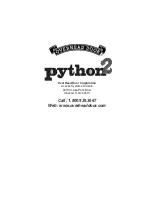
FCC and IC CERTIFIED
20
PROGRAMMING REMOTE CONTROLS
7
FIG. 8-1
Learn code button and LED
.
1. Programming
.
•
Locate learn code button and indicator LED
on front of power head (under force
adjustment screws)
(Fig. 8-1)
.
•
Press and release learn code button.
–
Indicator LED will blink at a rate of twice
per second.
•
Within 30 seconds
, push remote control
button once.
–
Indicator LED will stop blinking and stay on.
•
Press remote control button again.
–
LED will go out. Remote is now programmed.
2. Operating.
•
Press remote button once.
–
Door will move.
•
Press button again.
–
Door will stop.
•
Press button again.
–
Door will move in opposite direction.
The door will stop automatically at the fully open
or fully closed position.
SINGLE BUTTON REMOTE
This device complies with FCC Part 15 and RSS
210 of Industry Canada. This equipment has been
tested and found to comply with the limits for a
Class B digital device, pursuant to Part 15 of the
FCC Rules. These limits are designed to provide
reasonable protection against harmful interference
in a residential installation. This equipment
generates, uses and can radiate radio frequency
energy, and if not installed and used in
accordance with the instructions may cause
harmful interference to radio communications.
However, there is no guarantee that interference
will not occur in a particular installation. If this
equipment does cause harmful interference to
radio or television reception, which may be
determined by turning the equipment off and on,
the user is encouraged to try to correct the
interference by one or more of the following
measures:
Re-orient or relocate the receiver antenna.
Increase the separation between the operator
and receiver.
Connect the operator into an outlet on a circuit
different from that to which the receiver is
connected.
Consult your local dealer.
CONTACT REVERSE TEST
The force adjustments and limit switch
settings MUST BE COMPLETED before testing
contact reverse
.
1. Testing
.
•
Open garage door using wall control.
–
Place a 2" x 4" board (laid flat) under center
of garage door opening
(Fig. 7-5)
.
–
Close door using wall control.
•
When door hits board, it must stop and
reverse (within 2 seconds) to open position.
2. Adjustment
.
•
Door does not properly reverse.
–
Check to see if door is at “close” limit.
–
It should not have reached limit switch
before hitting board.
•
Door is at close limit switch.
–
Move limit switch closer to door.
•
Test again. Repeat as necessary.
•
Door is not reaching “close” limit, but
still does not reverse:
–
Decrease “CLOSE FORCE “ setting
slightly (turn it counter-clockwise).
•
Test again. Repeat as necessary.
FIG. 7-5
2 x 4 under center of door opening
.









































